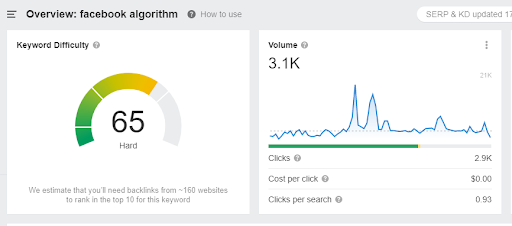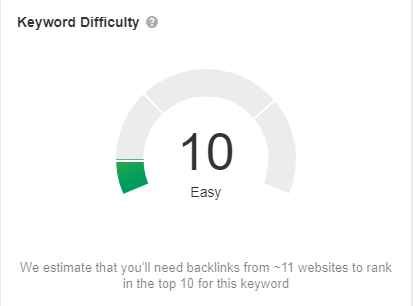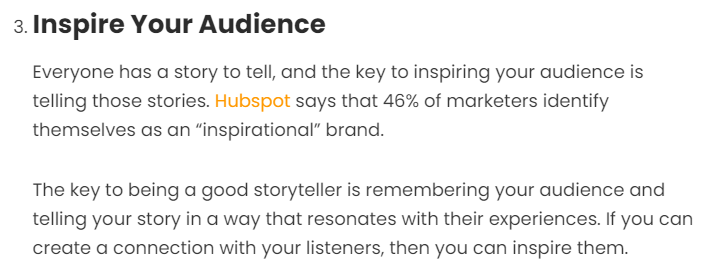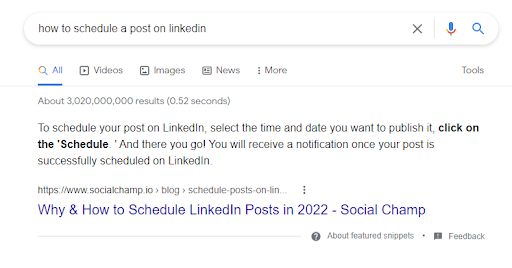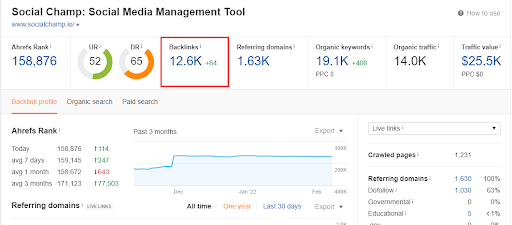As content producers, we often hear how our jobs are limited to JUST writing articles, but the world doesn’t see the grit and the never-ending process of creating something from scratch and making sure it reaches the top. Let’s be honest, we have all been at crossroads with articles when our pieces are not ranking at their top-most potential.
Now, it might feel as if Google or other search engines are playing against you to bring down the ranking deliberately. But it is not true.
There might not be a cookie-cutter method to rank all SEO blogs, but at Social Champ, we have come up with a process that enables us to improve our ranking and climb Google’s social ladder. We have noticed a distinct change in our SEO blogs by following the procedure! Additionally, learning from the best SEO courses to enhance your skills and strategies for improved rankings can be a great idea.
However, before we dive into the process, let’s first talk about a few basics of content marketing to understand the point of working on articles that actually rank.
A Quick Overview of Content Marketing
In the world of business, it’s no secret that you need to have a solid online presence. But what many small business owners don’t know is that content marketing is one of the best ways to create a solid online presence.
Content marketing is the process of creating and distributing valuable, relevant, and consistent content to attract and retain a clearly defined audience. By creating and sharing interesting and helpful content, you can attract more visitors to your website, build trust with your audience, and generate leads and sales.
With content marketing, you create an experience or information that is educational, informative, and entertaining. You are guiding your readers through an experience that they appreciate so much they decide to share it with other people. You build a tribe of followers who like, trust, and respect you enough to follow you anywhere.
Content Marketing and Business
Content marketing is helpful in business for several reasons; it’s a great way to add value to any product or service and access niche markets that wouldn’t have been accessible before. Marketing content on different socials, websites, and more can bring about a whole new set of audiences that matches your target.
Furthermore, it can put your content in front of your already loyal audience and show them that you are wherever they are.
Here are a few more statistics that are sure to convince you to get on the content marketing bandwagon today:
- Business with SEO blogs gets 67% more leads than other companies.
- According to studies, 47% of the buyers view 3 to 5 content pieces before they converse with the sales representatives.
- Companies using content marketing see approximately 30% higher growth than those not using it.
- 82% of marketers use content marketing more actively.
- WordPress users produce around 70 million new posts and 70 million new comments.
That’s the power of content marketing. This was just the overview of how content marketing can drive leads to your business.
How Social Champ Manages to Rank SEO Blog From 0 to 1st Position on Google
Setting the right mindset from the very beginning is essential to ensure a higher ranking. You should always focus on creating quality content that would add value to the reader’s knowledge base.
From the beginning, focus on writing SEO blogs that would rank and impact. We started our blog from scratch, which is why it took us several tries to take it where it is right now. After a lot of trial and error, we finally found a few techniques that work!
Here is our content production process that we try to follow all the time. We do make minor adjustments and tweak the process wherever necessary.
Phase 1 – The Keyword Research Process
So, what’s the first thing you do when you are writing an SEO blog, of course, research, right? So, when it comes to the keyword, pay attention to the core elements of keyword research.
Keywords are the foundation of SEO because if nobody is searching for what you are writing about, your article won’t get traffic on Google keyword ranking no matter how hard you try. To make your keyword research easier, here I have narrowed down the core elements of keyword research that you need to pay attention to while doing your research for the keywords.
Core Elements of Keyword Research
The core elements of keyword research are as follows.
Relevancy
Basically, Google ranks your content based on the relevancy of your keywords. It will rank your content higher only when it meets the requirements of the searchers’ needs which means when your content has relevant keywords that people search for.
These keywords also ensure that your content is in-line with what your audience is looking for.
Authority
The next is the authority of the keyword. Google provides more weight to all those sources that are authoritative. This means that your content must be enriched with all the informative and helpful websites so that the content can earn more signals and backlinks.
Volume
The last and essential core element is Keyword volume. The volume of keywords is measured by (monthly search volume). That means how many people search for that specific keyword. These core elements have a huge impact on your SEO blogs.
Switch to Easy Content Scheduling
Create, Edit, Schedule, Publish and Analyze all your social media posts with Social Champ
Keyword Research Tools
If you are wondering where you can find the top searched keyword, then you can go for such top-rated tools listed below:
⦁ SEMrush Keyword Magic Tool
⦁ Ahref Keyword Explorer
⦁ Google Keyword Planner
⦁ Moz Keyword Explorer
⦁ Keyword ToolPick Out the Right Keyword
So how do you find the right keyword for your SEO blog? Here I have narrowed down the few things you need to consider before choosing the right keyword.
Keywords That Drives Traffic
Firstly, search those keywords that drive more traffic to your website. Here is an example of a keyword (Facebook Algorithm).

Keyword With High Search Volumes
When you have chosen your keyword that drives traffic to your website, the next thing is to look out if the keyword’s frequency is higher or not.

Keyword With Low Difficulty Scores
KD is actually a keyword difficulty score. You can measure a keyword difficulty from 0 to 100 on the scale. The best practice is to choose low-frequency keywords because it is less competitive and helps your content rank more quickly.

Competitor Analysis

Lastly, keep a sharp eye on your competitors. Sort out your top 5 competitors and check their strengths, weaknesses, organic traffic, top ranking keywords, top pages, backlinks, primary, secondary keywords, keyword frequency, and word count.
Once you have followed all the given points above, now is the time to move to your next step. That’s the writing process.
Phase 2 – SEO Writing Process
SEO writing is all about creating content that is both search engine friendly and interesting to your audience. To improve your SEO, you must consider the following valuable tips.
Research
Before you start writing your SEO blog, you need to research to figure out what you want to write about and attract an audience. Search for the top-ranking articles, read them, and see what key points they have used. Once you have conducted the research, create a rough draft of all the pointers you think are essential and attract your audience.
Your SEO blog topic should be related to your business and one that your audience can relate to.
Use Creative Headings
Headings help organize your thoughts and make the content more skimmable. This is why it is super important to include headings, pointers, and bullets in your articles. This way, your audience can directly find the text they are interested in rather than going through boring, long, and never-ending paragraphs.
For instance, I have used a creative heading for the Facebook Algorithm blog. You can come up with unique and eye-catchy titles that attract your audience’s attention at once.

Write for Humans
When writing for your SEO blog, you should always keep your audience in mind. Don’t write for search engines; Do SEO writing for humans!
This is how you can write for humans;
⦁ Write engaging and relatable content.
⦁ While writing, keep your audience’s interest in mind.
⦁ Write in a more conversational tone, which shows that you are talking to the reader rather than throwing big chunks of information at them.
⦁ Write in a non-repetitive manner so that each word is of value.
⦁ Be clear and concise. No need to include extra fluff.
⦁ Add statistics, facts, and quotes to make it more exciting and creditable.Include Keywords in Your Content
Including keywords in your text is super crucial. But it is important to remember that you are writing for humans, which means that too many keywords in your articles can actually make it hard to read. Include keywords at intervals and do not overload the text. Ensure that all the keyword instances make sense and that it does not seem forced.
For example, I have equally distributed all the keywords in this article here.

Link to High-Authority Websites
One of the best ways to improve the credibility of your blog is to include links to high-authority websites. Not only will this help your blog appear more reputable to your readers, but it will also help to increase your own website’s authority. When selecting sites to link to, be sure to choose those relevant to your SEO blog topic and have high domain authority.
Furthermore, keep the anchors short and clean.
For instance, here, I have used high authority website links to improve my SEO blog’s credibility.
Aim for Longer Blog
As a blogger, you want your readers to stick around, right? So how do you keep them engaged? One way is to aim for scannable but detailed blogs. That means breaking up your content into easily digestible chunks, using headings, lists, and short paragraphs. And don’t forget to use images and videos to break up the text. According to research, the ideal length for a blog is between 2100 to 2400.
Longer SEO blogs give you a better chance to cover the topic in-depth and provide more value to your readers as well.Compress Images for Fast Page Load Speed
Images are a necessary part of most web pages, but they can also significantly slow down page loading time. By using compression, you can reduce the file size of your images without sacrificing quality. This can be done in several ways, depending on the format of the image, and you can use multiple online tools to compress them.
For instance, when it comes to compressing images, I use TinyPNG.Add Feature Snippets

Featured snippets are a specific SERP result that appears at the top of the page and includes a brief answer to the user’s query. To rank your content for featured snippets, you will need to ensure that it’s well-formatted and has all the necessary information to answer the user’s question. So, it’s important to add a featured snippet to your SEO blog.
Phase 3 – On-Page SEO
There are several ways to improve your website’s visibility on search engines. One of the most effective is on-page SEO. This involves optimizing your website’s content, titles, and metatags to better align with search engine results. Here I have narrowed down all the essential elements of On-page SEO.

Include Your Keyword in the Title
Including your keyword in your SEO blog’s title will help you rank higher on search engines when people are looking for information on that topic. Make sure that your keyword is included naturally and relevant to your topic.
Here’s are the best practices for your title:
⦁ Add power words in your title.
⦁ Watch your title length.
⦁ Don’t overstuff your title with the keywords.
⦁ Try to put the important keyword first.Use Short and Descriptive URLs
A descriptive URL is a massive help for directing people to your blog post. It gives readers an idea of the blog post before opening it. This is especially beneficial, as people are more likely to click on a URL that looks interesting. When creating your blog post, make sure to use a short and descriptive URL that accurately reflects the SEO blog post’s topic.
Compelling Meta Description and Meta Title
Meta Description: A meta description is a short paragraph that appears beneath a link in search engine results pages. The meta description summarizes the web page’s content and encourages users to click through to the page. The ideal length for a meta description is 120 characters or less. Ensure that it includes your target keyword to help improve your search engine ranking.
Meta Title: Meta title summarizes the topic of your blog post. So make sure it accurately describes the content inside. Use keywords to help your SEO blog post rank higher in search results. Keep it short, around 60 characters or less. That’s enough to catch someone’s attention without being too long or wordy.
Find and check out those blogs that have no meta description and meta title, add captivating meta description and title with the proper keyword in it.
Here’s an example of meta title and meta description.

Join Our Facebook Community
Get in touch with the top industry experts and get all the latest industry updates from the community specialists
Use Alt Text
Alt-text is important for SEO, as it helps Google understand what an image is about. When you add alt text to an image, be sure to use keywords related to your blog post’s topic. This will help your SEO blog post rank higher on search engine results pages.
Use Internal and External Links
Adding internal and external links is an effective way to improve a blog post. Internal links help readers navigate a blog post and find related posts. External links provide readers with additional information and resources. By adding internal and external links, SEO blogs can help readers explore a post in more depth.
Find and Fix Duplicate Content
Duplicate content refers to the similar or exact content that can be found on multiple pages within your website or others. Basically, duplicate content doesn’t add value to the readers and should be avoided at any cost.
Fix all such pages so that your website has fresh content.
Organize Topic Clusters
Organizing a topic cluster is an essential part of any SEO strategy. A topic cluster consists of three main parts. The first is pillar article, content cluster, and hyperlinks. Here’s how you can create your topic cluster.
⦁ Conduct a content audit and decide the topics that you want to include.
⦁ Identify main topics and subtopics from the selected ones.
⦁ Strategize subtopics and create a flow.Update Outdated Content
Filter the old content and update it with new information and images. Change meta description and meta title, add/change relevant keywords, include the latest content, close content gaps, and add new stats and screenshots.
Phase 4 – Off-page SEO
Off-page SEO is one of the most important aspects of SEO. It is the process of optimizing your website through external methods, such as backlinks, social signals, and much more. Off-page SEO can help improve your website’s visibility and credibility, leading to more traffic and higher rankings.

Backlinks

Backlinks are links from other websites that point to your website. The more backlinks you have, the higher your website will rank in search engine results pages (SERPs). The best way to build backlinks is to create great content that people will want to link to. Backlinks are an essential part of your SEO blog.
Social Signals

Off-page SEO majorly is all about creating signals to Google that your site is authoritative and popular. There are several ways to do this, and one of the most powerful is social media. By creating high-quality content and sharing it on social media, you can create links and signals that will help your site rank higher in Google keyword ranking.
Guest Blogs
The next is guest blog opportunities. You may have heard or even have seen multiple guest post opportunities. Several blogs are open for guest blog opportunities. Search for the keywords, create compelling content, send your article with proper keywords, images, and word count, and contribute as a guest author to those websites offering guest blog opportunities.
Phase 5 – Technical SEO
Technical SEO is the practice of optimizing a website for the technical aspects of search engine optimization. This includes optimizing the website’s architecture, coding, and structure for the best possible search engine visibility and performance.
There is a lot that Technical SEO covers, but the main aspects are making sure that your website is crawlable, indexable, and accessible to both people and search engines. You also need to make sure that your website’s technical foundation is vital so that you can effectively compete in today’s market.
This includes developing a site architecture that supports your marketing goals, installing the proper tracking and analytics tools, and setting up 301 redirects when needed. If you can manage all of this effectively, you will be well on your way to achieving great success with your website. So, make sure to utilize technical SEO in your SEO blogs.
Why Does Your Content Not Rank on Google?
There are many reasons why your SEO blog might not rank as high as you would like it to on Google. One of the most common reasons is a lack of SEO (search engine optimization) on your website.
Without proper SEO, your website will not be as visible to potential readers as it could be. Another reason your blog might not rank as high as you would like is because of low-quality content. If your website is full of spelling mistakes, low-quality images, and irrelevant information, Google will likely not rank it as high as websites with high-quality content.
Finally, one of the most common reasons SEO blogs do not rank as high as possible is a lack of backlinks. If you do not have any websites linking back to your blog, Google will likely not consider it as authoritative as websites that do have backlinks.
Applying the above SEO tips can help you to rank higher on Google.
How Can You Fix It?
The best way to rank your articles on Google will vary depending on the topic of your article and the keywords you are targeting. However, here are some tips to help you rank your articles on Google:
⦁ Use keyword-rich titles, write quality content and add backlinks from high-quality websites.
⦁ Perform keyword research to determine which keywords are most relevant to your topic. Use those keywords throughout your site, including in the title, the body of the post, and the Queries section of your Google Search Console account.
⦁ Publish high-quality content relevant to your audience and provide value to them.
⦁ Promote your content on social media and other online platforms.
⦁ Build links to your site from other reputable websites.
⦁ Monitor your site’s search engine rankings and make adjustments as needed.
You can help your blog rank higher in the search engine results pages by following these SEO tips, resulting in more traffic and more leads.


